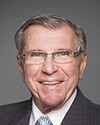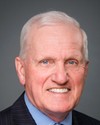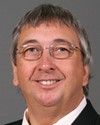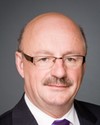Good morning, ladies and gentlemen.
As Madam Verner explained, the Official Languages Program Transformation Model ushers in a whole new approach to managing official languages in the Department of National Defence and the Canadian Forces. Like my honourable colleague, I have taken a strong personal interest in this initiative and I welcome the chance to talk to you about it.
As you know, the Transformation Model comes into effect at the beginning of April. I am confident that it will promote the Official Languages Program in the Department of National Defence and the Canadian Forces.
The previous approach failed to meet the needs of the Official Languages Act and our new approach will fix the problems and myths of the previous approach. I believe its implementation will also significantly improve our compliance with the Official Languages Act.
Let me begin by assuring you that I recognize the importance of supporting and promoting the use of both official languages. I believe that it takes a well-integrated defence team to get the job done, a team in which military and civilian francophones and anglophones can work seamlessly together. I also know that the ability of the Canadian Forces to function in both languages can be a distinct advantage in the conduct of operations around the world and an absolute necessity for operations here at home.
The Canadian Forces have a long history of recognizing both English and French in the workplace. In 1914, well before there was any thought of an official languages act, the Royal 22e Régiment became Canada's first official French-speaking regiment.
When the Official Languages Act was enacted in 1969, the Canadian Forces formalized their system of designating units as English-speaking, French-speaking, or bilingual. These designations underwent some adjustments in 1988, when the Official Languages Act introduced a regional system for the linguistic designation of federal work environments. The national capital region, eastern and northern Ontario, and areas of the province of Quebec and New Brunswick were designated by the federal government as prescribed bilingual regions for language of work purposes under the act.
The military establishment periodically reviews the language designation of all its units to ensure they remain compliant with the act.
On top of this, to meet their operational requirements, the Canadian Forces have created a number of bilingual work environments outside the prescribed bilingual regions. Units in Trenton, Halifax, Winnipeg and Esquimalt are good examples of this. These designations have assisted the Canadian Forces in building and maintaining a strong bilingual presence in all 10 provinces and 3 territories. However, confirming the language designations of our units was not the only action we took in response to the Official Languages Act.
The Canadian Forces adopted a universal approach to bilingualism. That is, the Canadian military set a goal for itself of providing second-language training to every regular force member so that the entire institution would be fully bilingual.
Overall, the Canadian Forces have an enormous bilingual capacity. Over one-third of our men and women in uniform are bilingual to some extent. But the military's bilingual capacity is scattered throughout the length and breadth of the organization. It is not concentrated in the functions or at the language proficiency levels required by the act. Accordingly, universality has not proven to be the answer for the armed forces. It has wasted the before-mentioned capacity of our forces.
The Auditor General's 1990 annual report also questioned whether this was the way to go for our forces, as it did not seem to be sufficiently meeting the requirements of the act.
So, why has the universal approach not worked for the Canadian Forces? Well, there are a number of reasons for this, and I would like to highlight some of them for you.
First, the scope of the universal approach was unattainable. The Canadian Forces' training capacity cannot realistically create a full bilingual military, despite the significant investment we've already made and are continuing to make in language training. Because the language training effort has been universally focused, it has not concentrated on where bilingualism is needed to comply with the act.
Second among federal institutions, the Canadian Forces' role and structure are unique. For operational reasons, military personnel are subject to hiring, training, and employment practices very different from those of the public service employees.
For example, the Canadian Forces take a functional approach to staffing, managing personnel by unit rather than by position. Each unit operates as a team to carry out its assigned mission. Commanders have the authority to relocate personnel within their units, as needed, to carry out these missions. This includes relocating bilingual personnel whose language qualifications may be needed in different functions to meet official languages obligations. Military personnel are not and cannot be employed against fixed positions in the way public servants are.
Yet, the Canadian Forces have been taken to task by this committee for not filling their bilingual "positions". I want to point out that the Official Languages Act does not mention "positions". It simply states that federal institutions are required to maintain a sufficient bilingual capacity to provide services and supervision in those cases provided by the act.
Our armed forces do an incredible job on this front, but the frequent postings and operational deployments that are part of military life exacerbate the challenges encountered by the Canadian Forces in consistently meeting the expectations of the act. It is simply neither realistic nor feasible for the Canadian Forces to meet demands that go beyond the expectations of the act, such as meeting public-service-related staffing requirements.
I firmly contend that a shift is needed to improve the official languages record of the Canadian Forces. However, counting the number of bilingual military personnel serving in bilingual functions, as the public service does with its positions, does not measure whether these functions are being delivered in both official languages, and it simply does not work for the Canadian Forces. What is required is language training that is better focused where it is required, and a results-based performance measurement system that accurately determines whether supervision, leadership, and training are being provided in both official languages when and where they are required by the act. The transformation model proposes to do just that.
The Commissioner of Official Languages recently published two reports. The first was on the impact of language of work on the recruiting, appointment and transfer of unilingual personnel to bilingual positions in the Canadian Forces. And the second was an audit of the language of work at National Defence Headquarters. In both cases, the commissioner found that the Canadian Forces were not in full compliance with the act.
All the recommendations made by the commissioner in these two reports have been taken into account and are formally addressed in the transformation model. Let me emphasize again that the aim of the transformation model is to better comply with the act.
As Madam Verner mentioned, the Commissioner of Official Languages will follow the implementation of the transformation model with interest. The new model sets out both the strategic plan and the road map for better aligning our official languages program with the act. It takes into account the integrated nature of the department and the Canadian Forces.
The civilian part of the department's official languages program will remain firmly rooted in the public service policies and directives emanating from the Official Languages Act and the Public Service Employment Act. The Canadian Forces, which are not subject to the Public Service Employment Act, must produce their own official language policies, directives, and procedures to implement the Official Languages Act. This has always been the case.
For the Canadian Forces and the Department of National Defence, the implementation of the transformation model will ensure that linguistically qualified personnel are provided in the right place at the right time. Defence team members are fully aware of their official language rights and obligations, and the institution's ability to meet the requirements of the Official Languages Act is accurately monitored.
At this point, I should mention the ongoing Project to Review the Linguistic Designation of CF Units, Civilian Positions and Military Functions. The review aims to ensure that National Defence has accurately determined which Canadian Forces functions—and civilian positions within those functions—must be designated as bilingual, and to which level of linguistic proficiency.
Once the review is completed, individuals employed in those bilingual functions and positions will be provided with second language training if they are not already at the required level of proficiency.
As you know, section 91 of the Official Languages Act sets out the principle that official language requirements related to staffing must be objectively determined. The review is being carried out with complete objectivity, in strict accordance with the criteria of section 91.
The model will also place a lot of emphasis on the senior military ranks. Senior officers have been receiving and will continue to receive priority access to second-language training. I want to stress this point because there is a false perception that bilingualism will no longer be a condition of service at the senior rank levels.
Since 2005, 70% of newly promoted colonels and captains (navy) at minimum, have been required to attain a superior level of language proficiency within a year of promotion. And the Canadian Forces have exceeded that goal each year. The objective will continue to be in effect under the transformation model.
The model requires all senior officers serving in bilingual regions or in bilingual functions to attain a superior level of language proficiency. This is the same measure used for senior public servants. The Canadian Forces will attain this ambitious goal by 2011, beginning immediately with the most senior general and flag officer rank levels.
Let me repeat that the model sets clear milestones for bilingualism among our senior officers. The levels of bilingual proficiency at the senior rank levels will continue to rise as a result of the transformation model.
A second misconception about the transformation model is that this will have a negative impact on career progression for francophones. Again, this is false. Approximately 24% of Canadians speak French as their first language, but francophones make up 27.4% of the Canadian Forces overall. They account for 32.9% of all chief warrant officers—that is, the senior rank, the non-commissioned rank—and 28.4% of all general officers.
Therefore, francophones are very well represented in the Canadian Forces. And they will continue to be very well represented in the future. Indeed, the transformation model will have a positive impact on the career progression of both francophones and anglophones.
It will ensure that all occupation-related training is consistently provided in both official languages from coast to coast, and that personal services to Canadian Forces members are offered to them in both official languages wherever they may serve, across Canada and abroad. This exceeds the intent of existing federal policies and practices, which result in training and most services being provided in both official languages only within bilingual areas.
The Canadian Forces objective related to provision of bilingual services and training will be facilitated through the transformation model. The model will accomplish this by better targeting second-language training to those who need to be bilingual to meet the requirements outlined in the Official Languages Act. This focused approach will better equip the Canadian Forces to fully meet their official languages obligations.
I have talked about how we will achieve the first aim of the transformation model: ensuring that linguistically qualified personnel are provided in the right place and at the right time. There are two very important issues that the transformation model will address: firstly, the lack of awareness of official languages rights and obligations.
The second question is the lack of an appropriate mechanism to measure National Defence's bilingual capacity and ability to provide services, training, and supervision where and when required by the act.
To address the first, the transformation model will put in place an enhanced official languages awareness and education program. This will ensure that civilian and military personnel are fully informed of their linguistic rights and obligations. The model will also establish a results-based performance measurement system to accurately monitor the provision of bilingual services, leadership, and instruction in accordance with the Official Languages Act.
Rather than counting bilingual military persons against positions, the new methodology will determine whether National Defence's military and civilian personnel are actually meeting their official languages obligations in the workplace. I'm confident that the transformation model will resolve the issues that the Commissioner of Official Languages raised, and will put to rest the concerns of those who have so recently spoken against it.
I would like to give you a snapshot for the future. A culture of respect for the use of both official languages will be actively fostered throughout National Defence.
Anglophones and francophones serving in bilingual functions will be provided with more ready and equal access to second-language training so that all military personnel are able to receive occupational instruction and personal services in their language of choice wherever they may serve, and members of the Canadian Forces are able to be led in their language of choice wherever official languages demands it. Change takes time, but we believe the implementation of the transformation model is the key to making the future a reality. At the same time, it will go forward toward enhancing the Canadian Forces' operational effectiveness.
Thank you very much.






